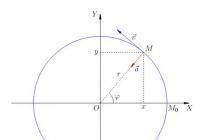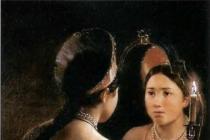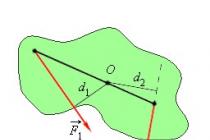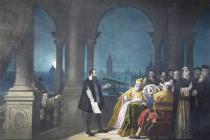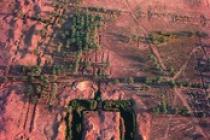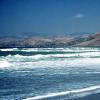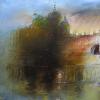It is difficult to find a person who would not have heard of a big diver, as the people called Newfoundland for quite understandable reasons: he loves water very much, can work as a lifeguard and even knows how to dive. A diver dog is a loyal friend and companion, a kind soul: he patronizes cats, dogs, children and is completely devoid of aggression.
The birthplace of the breed is Canada, namely, the island of Newfoundland. Even before the Europeans came to the island with their dogs, the locals already had shaggy faithful companions, without which it would have been much more difficult to survive in harsh conditions. The question of how the island off the coast of North America became the homeland of dogs that are absolutely not similar to aboriginal huskies is still open.
According to one version, the closest relative of the Newfoundland is, which could have got to the island from England. Another theory is that the dogs originated from a cross between black Scottish shepherds and French butcher dogs. The ancestors of the Newfoundlands could also have been Norse Viking dogs, Portuguese water dogs and Irish dogs. Canadians actively used Newfoundlands to collect catch and nets. A distinctive innate quality of dogs is the ability to dive; they can dive under water to a depth of 4 meters. It is not surprising that the second unofficial name for the breed is diver.
Since the 18th century, the breed of diving dogs has been documented. Rumors about the exceptional working qualities of the good-natured giants quickly spread in the Old World and animals began to be taken out of the island. Detailed descriptions of the Newf can be found in books on dog breeding in England since the middle of the 19th century. Some English ancestry can be traced back to 1850. In 1886, the English Newfoundland Club was founded, and a standard was developed that practically did not change.
From England at the beginning of the 20th century, the Newfoundlands quickly spread to Western Europe, and came to America. In Russia, the breed became popular after the collapse Soviet Union.
It is interesting! Often, hearing combinations of words - Newfoundland and Labrador, people think that we are talking about a breed of dog. In fact, this is not at all the case. After all, the combination of Newfoundland and Labrador is the name of the province of Canada with the capital of St. John's, which includes the island of Newfoundland, which gave the world the dog breed of the same name.
Video review of the Newfoundland dog breed (diver):
Appearance and standards
Newfoundlands are large and massive dogs. Their physique is a little rough and not distinguished by grace, but in the movements one can trace lightness and firmness. Males reach a height of 72-74 centimeters at the withers, females - 68-70 centimeters. Body weight varies between 55-70 kg. What representatives of the diver dog breed look like can be seen in the photo in the article and gallery.
Head and muzzle
The head has a wide skull and a well-developed occipital protuberance. The forehead and muzzle are smooth, without wrinkles. The stop is pronounced, but not abrupt. Muzzle: Moderately short and deep, well-defined, square in shape. The nostrils are well open, the nose is large black, in dogs of the corresponding color it can be brown. Straight and scissor bite is allowed. The eyes are relatively small, set deep and widely spaced. The eyelids should not sag unnecessarily. The color of the eyes is brown (light or dark, depending on the color). The ears are small, triangular in shape, set on the sides, close to the cheekbones.
Body type
The body is compact, its length from the withers to the root of the tail is equal to the height at the withers. Bitches can be more stretched out and less massive. The neck is strong, long enough to ensure a noble fit of the head. There should be no overly pronounced dewlap. The skeleton is massive. The topline is straight and firm. The back is wide. The croup has an angle of inclination of 30 °. The chest is voluminous, deep and wide. The line of the chest and abdomen is straight. Forelegs and hindquarters straight, parallel, very strong and well muscled. The tail is strong, wide at the base. In a calm state, it is lowered and slightly curved at the end, in an excited state it is carried high, but not thrown over its back.
Coat and colors
The coat is double. The guard hair is long and straight (slight waviness is allowed). The undercoat is thick and soft. On the muzzle and ears, the hair is short and soft. Feathers adorn the legs and tail.
According to the breed standard, Newfoundlands can only be black, brown or black and white (there should be a white blaze on a black head, a black "saddle" on the back and a black spot on the croup that captures the base of the tail). The rest of the body is white with a slight speck. In solid black or brown color, white markings on chest, tip of tail and toes are allowed. Black should be as saturated as possible. In the warm season, it can fade and acquire a slight brown tint.
By selecting black and white Newfoundlands according to certain characteristics, a breed called Landseer was obtained. No other blood flowed to them. Most kennel clubs consider these black and white dogs to be a Newfoundland variety, but the ICF distinguishes the breed separately. The dog breed is a diver in the photo practically does not differ from the Landseer.

Character and psychological portrait
A subtle and vulnerable nature is hidden behind a formidable appearance. Newfoundlands are very good-natured and sensitive. They do not accept criticism. They often show stubbornness and independence. Inside the seemingly formidable and angry dog there is a small restless puppy, which is distinguished by affection and kindness.
Newfs quickly and firmly become close to all family members, therefore, it is hard to go through long partings and a change of owners. They get along well with other animals in the house and do not show aggression towards them. They can even make friends with dogs of miniature breeds. Moreover, having adapted to the house, they become so peaceful that cats cease to be afraid of them and can sleep, climbing on the backs of warm fluffy dogs.
Newfoundlands are capable of loud frightening barking, but they rarely give a voice, and people around them are often afraid to approach them due to their impressive size. Divers, in turn, are very friendly to strangers.
These animals are so imbued with love for the family that supports them that they begin to patiently protect the mischievous babies. Newfoundlands love to participate in the games of grown-up children and are happy to accompany them on various trips, keeping an eye on the safety of the "wards".
The seemingly massive and formidable-looking Newfoundland diver is not at all suitable for the role of a guard of a backyard territory or as a hunting dog. When the first representatives of the breed began to populate the island, there was no one to hunt there, and the local population hunted mainly by fishing. Accordingly, humans did not need dogs with hunting skills. Friendliness and loyalty, along with an agreeable character, were valued much more.
The inhabitants of the island of Newfoundland deserve special thanks for the development of such qualities in dogs as the ability to make decisions and outstanding intelligence. The fishermen needed a complete companion capable of such assistance as:
- delivery of cargo;
- babysitting;
- a guide in darkness and fog.
Only those animals that met the above requirements passed natural selection. As a result, we see a Newfoundland diver who, although not entirely obedient, is able to react quickly in an emergency and make the only correct decision.

Newfoundlands are large dogs, so keeping them in a city apartment is very problematic, but possible. Divers are large and sometimes not too neat, at home the dog should have its own place, which will take up not a small area. Wool will be a lot of trouble, especially if you don't comb it out regularly. Another drawback is profuse salivation. In a private house, a Newf can easily live in an aviary, but it is worth remembering that this is not a dog for protection, it is, first of all, a companion who needs constant contact with a person.
For Newfoundland, life in a city apartment is not the best way... Unlike a country or private house with a large yard, where the dog can walk at any time.
Care
Dogs have a thick undercoat, are very prone to mats and need regular grooming. It is recommended to comb the dog several times a week. During the seasonal shedding period, you need to pay more attention to the coat and carry out the procedure daily. Frequent bathing is not required, it is best to wash the dog as it gets dirty, and also in preparation for the show. Carefully monitor the cleanliness of the eyes and ears.
Diet
Newfoundlands need a complete, balanced diet. At the same time, you can feed both natural food and ready-made food. The choice of the type of food depends on the owner. It is important to remember that representatives of the breed are prone to obesity, so it is worth observing portion sizes and not overfeeding the dogs, even if the pet asks for supplements. Due to the risk of gastric and intestinal volvulus, Newfoundland should not be fed immediately after or before exercise.

Training and appointment
Newfs are lifeguards by nature, but they are excellent swimmers, which allows them to pull drowning people ashore. They can make dexterous jumps into the water from the side of the boat and swim up to the victim with a lifebuoy. Remarkable strength and intelligence determines their ability to quickly tow a boat, and in the northern regions, harnessed to a sled, they become carriers of heavy luggage. All this does not diminish their main feature - character, because you cannot find anyone more good-natured, friendlier and more loyal than Newfoundland.
The high intelligence and good memory of Newfoundlands allows them to quickly learn commands. They are always happy to do the exercises suggested by the owner. At correct upbringing and when trained they make excellent service dogs and good companions. When communicating with Newfoundland, always show understanding, show only positive emotions and encourage your pet.
A respectful attitude from the owner will motivate the Newf to train at full strength.
When training impressionable dogs, one should avoid using harsh methods, not physically punishing the animal. In addition, during upbringing, it is necessary to show perseverance and a creative approach, since the Newfies are quite stubborn and cannot stand monotonous activities.

To maintain good physical condition, they need daily walks with moderate physical activity, which will help prevent the development of diseases of the musculoskeletal system in dogs. Neuf will be happy to go for a morning jog and keep company for an evening walk or a hike in the woods. With age, dogs stop actively participating in children's games, quickly get tired and lose interest in them. Therefore, games should be varied and short-lived.
Since divers are massive dogs, it is best to organize slow jogging or active walking in the cool breeze. Newfoundlands love to swim and are always ready for a swim. If you do not want your pet to get wet unexpectedly, be careful when meeting any bodies of water while walking. Dogs of this breed adore

Diseases and life expectancy
Newfoundlands are distinguished by good health and endurance, they perfectly adapt to various weather conditions, only in hot sunny weather heat strokes occur due to the thick black wool. With proper care and good nutrition, dogs that do not have hereditary diseases live an average of 10-11 years.
Unfortunately, the breed cannot boast of perfect genetics. There is a whole list of diseases to which Newfoundlands are most prone to:
- Diseases of cardio-vascular system... The most commonly reported aortic stenosis (obstruction of natural blood flow that manifests itself with age), congenital defect of the cardiac septum and cardiomyopathy.
- Hip dysplasia: Can be unilateral or bilateral, and can range from mild to complete dislocation of the femoral head.
- Diseases of the eyes: volvulus and eversion of the eyelids, inflammation of the third eyelid. There is a genetic predisposition to these diseases, but more often they manifest themselves against the background of common inflammatory processes.
- Panostitis - inflammation of the long bones is found during the growth period.
- Acute expansion of the stomach and intestines followed by torsion is a severe acute condition that can lead to death without emergency help.
- Hypothyroidism
- Ectopia of the ureters manifests itself at birth in the form of constant urine leakage, more common in bitches.

Newfoundland puppy selection and prices
A cute shaggy ball that begs for your hands, and just by its appearance it lifts your spirits, that's what it is - Newfoundland puppies. Do not forget, very soon this ball will grow into a large and strong animal. Who he will be, punishment or joy, depends only on you.
If you are interested in the show career of a Newfoundland puppy, the price of a pet will depend on its passport - pedigree. It's good if the kid already had champions in the family, this is an additional plus.
The signs of marriage include:
- smooth wool;
- malocclusion;
- non-standard color (any spots other than white).
The behavior of the baby is of great importance. Signs of aggression indicate poor health or, worse, an atypical temperament for the breed. There is one unspoken rule about choosing a baby, you should buy a Newfoundland puppy if he himself came to you and, even better, climbed into your arms. External examination is of no less importance.
A good puppy should be active, socializing and have a good appetite. The skin should be clean, the coat should be shiny, the belly should be soft to the touch, the nose should be wet, and there should be no traces of discharge from the ears and eyes. Pay special attention to the paws - they are massive in a good exterior. The tail of Newfoundlands should be wide at the base, as it has to serve as a rudder when swimming. Signs of a breed defect:
- frequent manifestation of aggression;
- smooth wool;
- non-standard color (no white spots);
- malocclusion.
It is not advisable to buy a diver's dog, focusing solely on the photo, even if the price seems very attractive. It is always important to see babies and parents live, as well as communicate with the breeder, especially today this can be done through video communication.
Puppy price
Another important question: how much does a diver cost. The cost of a thoroughbred puppy from a kennel is on average 40,000-50,000 rubles. The price depends on the geography of the breeder, the quality of its producers, the prospects of the babies and many other factors. If a diver dog is needed only as a pet, you can consider the option of buying a puppy without documents, the price of outbred babies is lower, but no one can guarantee that a Newfoundland will grow out of a puppy as in the photo.
In general, buying a dog is easy. This is a widespread breed and Newfoundlands are sold throughout Russia. The situation is similar in Ukraine and Belarus. For example, you can buy a Newfoundland in Belarus in Minsk. All you need to do is visit your local bulletin board. In Ukraine, there are also sites for buying and selling puppies, if you doubt the reliability of private breeders, visit one of the many kennels of the breed.
Among other things, you can buy the Newfoundland breed through social networks, for example - VKontakte.
Breed Newfoundland (Newfoundland) is known to many dog breeders and dog handlers under the name "diver". Originally used as a working dog in Canada. A characteristic feature of the breed is the presence of peculiar membranes between the toes.
History of the origin of the breed
There are several theories about the origin of Newfoundland.... The most original is the version according to which the ancestors of the breed were the so-called "bear dogs", brought by the Viking Leif Erickson to the seaside provincial island of Newfoundland.
No less interesting is the assumption that the ancestors of Newfoundland are Tibetan mastiffs. Of course, there is no direct evidence of such a relationship, and there is no scientific evidence according to which the ancestors of modern "divers" came to North America from the territory of Tibet.
It is interesting! Their endurance, devotion and calmness, as well as their ability to easily withstand all the harsh climatic conditions of the Canadian island, modern Newfoundlands, most likely, owe to the breeds used in crossing.
The most plausible theory is the appearance of the breed in the process of absolutely natural development of Canadian dogs with a lush and water-repellent coat.
The emergence of the Newfoundland in this case is due to the crossing of Canadian dogs with breeds such as Mastiffs, Molossos, Portuguese and Scottish Shepherds.
Appearance, description
The standards give detailed description ideal, from the point of view of the breed, representative, which should be used by breeders as a model. Today, all breeders are guided by four official standards: English, American, Canadian and FCI.
All countries are members of the International Cynological Federation, in last years are guided by the latest edition of the FCI standard, based on many criteria based on the materials of the Canadian standard.
Breed standards
Newfoundlands are classified as cargo sled dogs and water dogs, which must meet the following breed standards:
- the body is compact, and the backbone is massive;
- the head is massive, with a wide skull, with a slightly convex arch and the presence of a well-developed occipital protuberance;
- the feet are well defined, but not sharp, and the nose is large and well-pigmented, the nostrils are well developed;
- the muzzle is square, deep and somewhat short, covered with rather short and soft hair, and the cheek area is soft;
- bite of a straight type or scissor bite;
- eyes are relatively small in size, somewhat deep-set and wide apart, dark brown or slightly lighter in color;
- ears not too large, triangular, with rounded tips, set on the back of the skull;
- the neck area is strong and sufficiently muscular, without excessive dewlap;
- the back area is wide, with a fairly strong and well-muscled lower back;
- the croup is wide, with a standard slope of 30 °;
- the front legs are fairly straight and parallel, and the hind legs have a strong, wide and long pelvic region;
- the tail is strong and broad at the base.
The breed is distinguished by a water-repellent double coat, sometimes with slight waviness and moderately long guard hairs. The undercoat is quite thick and soft.
Black, brown and white-black colors are allowed by the standards.... The average height of an adult male at the withers is 70-71cm. The average height of an adult bitch at the withers is 65-66cm. The weight of the dog is 67-68kg, and the bitch is 53-54kg.
Newfoundland character
Outwardly, Newfoundland simply "glows" with kindness and gentleness of character. Despite its extremely majestic appearance, this is a very cheerful and inventive dog, known for its meek and calm disposition.

The thoroughbred Newfoundland is almost completely devoid of basic hunting instincts, but is quite capable of making decisions on its own under some circumstances. The breed is highly regarded for its complete absence of aggression towards humans and other animals.
It is interesting! Scientists have proven that Newfoundlands very often see dreams, therefore, during rest, the pet whines, scratches and touches its paws, or, on the contrary, rejoices and wags its tail.
Newfoundlands are excellent swimmers, so they are very happy about any opportunity to take water treatments. However, it is extremely important to educate the puppy from the very first moments of his appearance in the house.
If necessary, you can show your pet to specialist breed breeders, who will help not only adjust the character, but also give practical advice on the maintenance and education of the Newfoundland.
Life span
The average lifespan of a massive dog with a powerful and muscular body and well-coordinated movements is only ten years.
Nevertheless, as the long-term practice of keeping such a breed at home shows, even very insignificant errors in care often cause a sharp reduction in the life expectancy of a Newfoundland.
Newfoundlands are not at all suitable for keeping in outdoor enclosures behind bars or on chains. This breed, as a rule, is kept in an apartment or in a suburban private house with a yard for regular walking.
Before purchasing a puppy, you must familiarize yourself with the basic rules for keeping it.... It is imperative to provide your pet with a place to sleep and proper rest, as well as eating.

The house should have a veterinary first aid kit, basic accessories for playing and exercising, as well as all items for performing hygienic care.
Care and hygiene
It is extremely important to regularly and competently care for the long coat of the Newfoundland. It is necessary to comb out the wool daily, using a brush with a stiff bristle type. The coat requires special attention during the shedding period.
In order not to violate the protective layer on the pet's coat and skin, it is necessary to avoid bathing the dog unless absolutely necessary. A very good result is obtained by periodically treating the wool with special dry shampoos.
The ears are examined weekly, and if areas of pronounced redness are found, the auricle is thoroughly cleaned with a cotton pad moistened with chlorhexidine, after which the skin is lubricated with synthomycin emulsion.
To remove secretions that accumulate around the eyes, use gauze soaked in clean water or special pharmacy lotions.
The nails are trimmed regularly to help shape the metacarpus and toes... You also need to ensure dental hygiene. For cleaning, special non-allergenic pastes and toothbrushes are used, as well as treats to remove plaque from the teeth. Tartar deposits are removed in a veterinary clinic.
Important! Despite the fact that bathing the Newfoundland is often impossible, from an early age, the pet needs to be accustomed to the obligatory hygiene procedures, including washing the paws after a walk and wiping the muzzle with a damp cloth after eating.
How to feed Newfoundland
The overwhelming majority of dog breeders have recently been actively using ready-made food for feeding pets, which can be given to the Newfoundland not only dry, but also pre-soaked in ordinary water or broth. In order to initially correctly determine the diet, you need to find out from the breeder what type of food the purchased puppy is used to. Of course, you can transfer the dog to a different type of food, but it is imperative to carry out such a change in diet gradually.
Important! Remember that when feeding a pet, the dog must be provided with unhindered access to clean drinking water.
The number of feedings and the rate of feeding will vary depending on the age of the pet:
- puppies from two to four months are given food five times a day;
- puppies from four months to six months are given food four times a day;
- at the age of six months to eight months, food is given three times a day;
- a pet older than eight months can be switched to two meals a day.
Ready-made feed rations are very diverse, but depending on the set of components and their quality characteristics, they can be presented in different classes.
Newfoundland can also be fed with ordinary natural diets, but in this case, you will need to correctly calculate the amount and type of food, as well as balance all the components and calculate the addition of vitamin and mineral supplements.
All products must be of high quality, not greasy and fresh.... It is necessary to feed a pet, regardless of weight and age, an hour after returning from a walk.
Diseases and breed defects
Any deviations from breed standards are considered faults. The main vices of Newfoundland include:
- high legs;
- looseness or lightness of the skeleton;
- aggressiveness or cowardice;
- narrow head and long or pointed muzzle;
- round or protruding yellow eyes with visible third eyelid;
- hunchback, weak or sagging back;
- short or very long tail with kinks or curls at the end.
Disqualifying faults include lack of temperament, distortions and undershot jaws, too short and smooth coat, incorrect color. The male should have a pair of developed testicles descended into the scrotum.

Newfoundlands also have a predisposition to certain breed diseases, which are represented by:
- dysplasia of the hip joints, which is accompanied by disorders in the development of the joint and can be on one side or bilateral. The most complex forms are characterized by complete dislocation of the femoral head from the acetabulum;
- diseases of the cardiovascular system in the form of aortic stenosis. Hereditary narrowing of the aortic opening obstructs natural blood flow. As a rule, the very first pronounced signs of the disease appear in a pet at the age of three months or slightly older;
- eye diseases in the form of turning the eyelid inward or outward. In the first case, the cornea is injured by eyelashes, which provokes the development of inflammatory processes, and the treatment can only be surgical. Outward curvature can be congenital or acquired, but also requires surgery. Less often, Newfoundland owners are faced with prolapse of the third eyelid, which is accompanied by tissue overgrowth in the inner eye corner;
- panostitis or painful inflammation of the long bones. The disease is better known as intermittent claudication or growing pains. Panostitis does not require treatment and disappears on its own with age.
Quite often, and practically regardless of age, Newfoundlands suffer from bloating or acute expansion of the stomach. This condition, also known as torsion, is where the stomach expands strongly from accumulated gas or fluid.
Failure to provide veterinary care in a timely manner can lead to the death of a pet. To minimize the risk of developing such a disease, it is necessary to avoid excessive physical exertion, not only before meals, but also immediately after feeding. It is equally important not to overfeed your dog.
Brief description of the Newfoundland dog breed
- Other possible names for the breed: Newfoundland, Newfoundland
- Height of an adult dog: males reach a height of 75 cm, females - 66 cm.
- The weight: males - 68 kg, females - 54 kg.
- Characteristic color: can be black, white with black spots and brown. The black and white Newfoundland species is called.
- Wool length: long (short on the face and ears), thick, two-layer, water-repellent.
- Life Expectancy: 12-15 years old.
- Advantages of the breed: known for their friendliness, desire for communication, balanced temperament. They are smart and serve people with pleasure.
- Difficulties of the breed: impressive size of the dog and grooming.
- average price for newfoundland puppies : 300-1000 dollars for a dog diver.
The place of origin of the breed is the island of Newfoundland off the eastern coast of Canada. In these lands, even before the advent of our era, there were settlements of North American Indians who bred domesticated dogs. At the end of the IX century. AD Vikings colonized this area and brought with them large black "bear dogs".
Later, during the next discovery of Newfoundland by Europeans, many new breeds were brought here: Pyrenean mountain, Portuguese water, some species of shepherd dogs. It is assumed that the Newfoundland breed appeared as a result of crossing aboriginal livestock with dogs of Europeans and descendants of Norwegian black dogs. This mixing, combined with the cold climate and the practical needs of local farmers and fishermen, resulted in a large, strong dog with long hair.
This breed is currently is very popular in North America and Great Britain. In Russia and the CIS, Newfoundlands are not so widespread.
 Newfoundland is friend dog, companion dog... It is not at all aggressive towards people and animals, therefore it is not suitable for protection and protection. He has practically no developed hunting instinct. The strong constitution of the Newfoundland, his power, endurance allow him to prove himself as an excellent human assistant.
Newfoundland is friend dog, companion dog... It is not at all aggressive towards people and animals, therefore it is not suitable for protection and protection. He has practically no developed hunting instinct. The strong constitution of the Newfoundland, his power, endurance allow him to prove himself as an excellent human assistant.
Initially, the breed was used to transport goods, search for people, including under water. Newfoundland is excellent search and rescue breed, they swim well, dive, they have a developed upper flair (the ability to catch odors in the air, and not just on the ground).
The most outstanding feature of Newfoundland is its gentle and kind character... Newfoundlands adore people and are always looking for communication with them. They get along well with children and pets. They are peaceful, calm, not prone to mood swings. Not cowardly at all.
Video review of the Newfoundland breed
We offer to see a good educational video review about Newfoundlands. The plot describes many Interesting Facts from the history of the breed, especially raising puppies. It also tells about water competitions among professional Newfoundland rescuers.
How to choose a diver puppy
 When deciding to purchase a Newfoundland puppy, you first need to decide for what purpose do you need a dog- to participate in exhibitions, for pedigree breeding or just as a pet.
When deciding to purchase a Newfoundland puppy, you first need to decide for what purpose do you need a dog- to participate in exhibitions, for pedigree breeding or just as a pet.
Also an important selection criterion is sex of the animal: males are larger and more courageous than females, they are somewhat more difficult to manage, females are more attached to the house.
It is worth choosing a puppy only from an experienced breeder... A conscientious breeder will never sell a puppy without asking about the conditions in which he will live, and will also be ready to answer any questions about the care and education and after the sale.
When considering a small Newfoundland, pay the most attention to its proportional addition. The puppy is a miniature replica of an adult dog. By breed standard the length of the animal's body from the withers to the base of the tail must be equal to the height from the withers to the ground. Harmoniously developed puppies in adulthood will have correct posture and an easy springy gait. The coat should be smooth and shiny. Check the bite carefully.
Before making your choice, take a close look at all the puppies in the litter. Don't get a puppy that is aggressive towards your littermates - this is a characteristic feature of dominant personalities, and if you have no experience, dealing with such a puppy will be difficult.
Ideal age to move the puppy to new house it is considered 8-10 weeks. You can also safely purchase an adult dog, it will quickly become attached to a new family, if you pay enough attention to it.
Nicknames for Newfoundland
When coming up with a nickname for your Newfoundland, pay attention to its consonance with the tribal prefix. Pedigree also defines the first letter of the puppy's name. It's good if the name is not only sonorous, but also meaningful.
- Often Newfoundlands are given complex compound nicknames, highlighting their imposing appearance: Grand Cardinal, Ursa Major, Colossus of Rhodes, etc. For home use, it is better to come up with a short monosyllabic or two-syllable voiced version.
- Among the hosts males popular are the names of ancient heroes, military leaders, historical figures: Hercules, Poseidon, Plato, Caesar, Pontius Pilate, Tamerlane.
- Bitches often give soft, cozy names, for example, Aurora, Lada, Umka, Velvet Nights, Naiad, Muse.
- Originally, if the nickname reminds of the place of origin of the dog - St. John's, Avalon, Halifax, etc.
 Despite the fact that Newfoundlands are well adapted to harsh weather conditions, it is better to keep such a dog in the house, since she constantly needs communication. When kept in the yard, it is important that the Newfoundland has a spacious enclosure with a wooden floor.
Despite the fact that Newfoundlands are well adapted to harsh weather conditions, it is better to keep such a dog in the house, since she constantly needs communication. When kept in the yard, it is important that the Newfoundland has a spacious enclosure with a wooden floor.
For all their massiveness, Newfoundlands are quite mobile and hardy, therefore, walking the dog, it is important to give her regular good exercise.
How to feed Newfoundland
When feeding a puppy It is very important to follow the recommendations for the type of feed prescribed by the breeder, because he knows best how the dogs of his breeding line develop. At the age of 8-10 weeks, puppies are fed 4 times a day, at 3 months - 3 times a day, from 5 months - 2 times a day.
It is necessary to transfer puppies to the diet for adult dogs at 4-5 months. A dog over one year old can be trained to receive a one-time meal. Do not overfeed the Newfoundland.
 As soon as you have acquired a Newfoundland puppy (at the age of 2-3 months), you need to immediately accustom him to the leash and collar and master the basic commands with him.
As soon as you have acquired a Newfoundland puppy (at the age of 2-3 months), you need to immediately accustom him to the leash and collar and master the basic commands with him.
Newfoundlands are outgoing and inquisitive, so learn quickly and with pleasure... Since the puppy quickly grows into a large dog, you need to be able to clearly control it with the help of the commands "To me", "Stand", "You cannot", "Near". Immediately stop your puppy from jumping on people.
Advantages and disadvantages of Newfoundland
Dignity. Among all dog breeds, the character of the Newfoundland is unparalleled. Newfoundlands are not only smart, they are able to make their own decisions in difficult situations. They are sociable, obedient, playful and active at any age. They perfectly tolerate trips in transport, they swim well, they are not afraid of sharp sounds, bright flashes. They are infinitely loyal, affectionate, able to guess the mood of the owner and are happy to be helpful.
To the disadvantages of the breed the only thing that can be attributed is the need to regularly comb out the long fur of the Newfoundland and the occasional profuse salivation. Due to its large size, the cost of keeping a Newfoundland is slightly higher than that of small breed dogs.
The content of the article:
Newfoundland - that's the name of this huge dog with a massive, strong figure of a medium-sized bear. But strange to say, this huge dog, when met, does not cause any feeling of fear or apprehension in a person, he looks so friendly and peaceful. From him literally emanates an aura of benevolent strength and serene calmness. And this is not surprising, because in front of you is not a dangerous monster dog, but a swimmer-rescuer, a workaholic of the seas, completely devoid of aggression towards people, adored by adults and children.
The history of the origin of the Newfoundland breed
The history of the origin of the Newfoundlands has not yet been thoroughly studied. There are a number of hypotheses, each of which has strengths and weaknesses, and some of them seem too fantastic at all, bordering on legends.
So, according to one of the versions, it is believed that the direct ancestors of the mysterious Newfoundlands are the huge bear-like dogs of the famous Viking Leif Erikson, whom fans of Scandinavian culture consider the discoverer of North America. But Erickson's dogs had white hair, while the Newfoundlands had it classically black. And this is the most weakness version.
Other variants of origin, proposed by researchers, are simply replete with variations of all kinds of crosses. So the Canadian guide to dog breeds offers the following options: wild black wolf (now extinct) and Asian mastiff; a large Viking dog and a wild northern wolf; a complete mixture of dogs of all breeds introduced by Europeans in the XV-XVII centuries, from mastiffs to Portuguese water dogs.
The Americans, on the other hand, put forward their version and trace the Newfoundland pedigree from large mountain Pyrenean dogs, allegedly brought to the island of Newfoundland ("Newfoundland" - "newly found land") by Spanish or French sailors.
Soviet researcher, biologist and naturalist Igor Ivanovich Akimushkin proposed other options, removing the Newfoundlands from the variety of local "Viking dogs" and allowing their further interbreeding with Molossian dogs and black Scottish shepherds, who arrived on the island with the British in the 17th century.
So, as we can see, there are a great many options. And the point in the origin of the large black dogs of the island of Newfoundland will probably only be put by DNA research.
Be that as it may, but massive strong and brave dogs, on the exterior very close to today's Newfoundlands, at the time of official recognition, they had been used by local residents for several centuries, becoming the main aboriginal breed of this province. The main function of the aboriginal breed was to help local fishermen in their difficult job of catching cod that spawns in these waters. The dog swam and dived perfectly, was not afraid of storms or cold, was strong and enduring, helped to pull out lost nets and get objects dropped into the water, often rescued the fishermen themselves from the water.
The first Europeans to appreciate the working qualities of these large dogs were the British. It was they who began the already thoughtful selection of the future breed. Initially, aboriginal dogs of various colors took part in these works, but in the end the breeders relied on the uniformity of the color, choosing black and brown (more rare) coat colors.
In 1886, the first standard for a new breed was developed, and the first English Newfoundland Dog Breed Club was established in London. The breed inherited its name from its historical homeland - the Newfoundland islands.
Gradually, the breed gained recognition in others. European countries... And above all in Switzerland. The founder of the first European club was the Swiss cynologist professor Albert Harm. It is to him that the breed owes the appearance of brown purebred Newfoundland dogs.
At the beginning of the 20th century, black giant dogs, already in the status of a new species, returned to the North American continent, instantly winning the hearts of Canadians and Americans.
Nowadays, Newfoundlands are regular dogs of all championships; no serious exhibition on any continent of the world can do without them.
Purpose of the Newfoundland dog

Sometimes Newfoundland dogs are called divers (although a diver is a completely different breed, called a "Moscow diver"). And this is more than true, both in relation to their past and present. For centuries, these superb swimming and diving dogs have been used by fishermen for their hard work at sea. The hounds had to dive to the depths to save lost nets (and sometimes sailors who fell overboard), to get a variety of items from the cold northern sea. They helped to pull boats ashore, guarded the catch and tackle. These friends of man worked with might and main on land - dragging logs, beams, boards and other building materials by dragging.
Of course, these days, many of these skills are no longer needed. But Newfoundland dogs are still called divers and are often used in this capacity as rescue dogs on the waters. Moreover, pulling a person out of the water, the representatives of the breed have their own rescue technique, and towing a drowning person to the shore. The dog uses its fangs very carefully, and the drowning man is towed mainly on its back, carefully making sure that the person's head does not go under the water. There are cases when these big dogs swam up to 20 km, saving people.
In addition, diving dogs are now actively used as search and rescue dogs to search for lost tourists and climbers in snowy mountains, as well as in programs for the rehabilitation of mentally ill, disabled and elderly people.
External standard and description of the Newfoundland breed

The Newfoundland is a large dog with a large head, massive muscular body and fine thick black or brown coat. Such a dog is distinguished by its unhurried majesty and calm, balanced behavior, sometimes in appearance it resembles a well-fed bear, and not a dog. Perhaps, he also causes such a bearish association because of the peculiarity of his slightly bearish look, curious, but "lazy."
The Newfoundland breed is a large breed, reaching a withers height of up to 71 centimeters, and a body weight of almost 70 kg. Females are somewhat smaller, height - up to 66 centimeters and weight - up to 55 kg.
- Head massive, with a wide, convex skull and a well-developed occipital protuberance. The muzzle is square, pronounced, wide and somewhat short. The stop is pronounced, but not abrupt. The bridge of the nose is straight and wide. The nose is large, well-defined, with large nostrils. The color of the nose depends on the color. In black dogs it is black, and in brown dogs it is brown. Lips, adjacent to the jaws, have flews. Lip color matches color. The jaws are strong, the number of teeth is standard. The teeth are large, white, with pronounced canines. Straight or scissor bite.
- Eyes rather small, wide and deep set, with close fitting eyelids. Eye color is brown or dark brown (in dogs with black fur).
- Ears small in size, triangular in shape, with rounded tips. The length of the ear reaches the inner edge of the eye of the same name.
- Neck very strong, muscular, medium to long in length. The neck provides a special "noble" posture to the animal. The nape is noticeably developed.
- Torso square type, massive, somewhat bearish, with a wide voluminous chest. The back of the Newfoundland is very strong and wide. The back line is straight. The croup is powerful, sloping.
- Tail strong and wide at the base (in the water the dog uses it as a rudder), medium set, well furred. The tail is never slung over the back or tucked between the hind legs.
- Limbs straight, parallel, well-developed bone and musculature. The toes are closed. There are interdigital membranes. The paw pads are firm. The nails are very strong, black in black dogs and slate gray in dogs of a different color.
- Wool has water-repellent properties, consists of straight (sometimes slightly wavy) and long guard hair and dense dense undercoat. In winter, the undercoat is much thicker. On the head, the cover is soft and relatively short, on the paws there are rich feathers, the tail is covered with long hair.
- Color Newfoundland. The most traditional coat color is deep black. There are brown and white-black dogs. In a solid shade, white spots are allowed on the chest, toes and on the tip of the dog's tail. With the white and black version, the distribution of the spots must meet certain conditions. The brown color scheme allows variations in shades from deep bronze to dark chocolate.
Newfoundland character

Starting a conversation about the character of Newfoundland dogs, one can cite an excerpt from an old description of the breed: “How noble his appearance and at the same time calm his disposition! Probably no other animal is capable of showing more real courage than this dog ... Many people were saved by it from death in the abyss; she threw herself into the sea from the side of a sinking ship and carried the rope ashore, saving her entire crew with her actions. "
Indeed, the nobility and calmly peaceful nature of this dog, combined with its strength, endurance and courage, make it just a wonderful companion for humans.
These big dogs very smart, inquisitive and very quick thinking. And yet - they have their own opinion, which inevitably has to be reckoned with, given the rather large size of the "dog". By nature, these animals value the expediency and functionality of any action, without wasting them on trifles. Therefore, the commands given to them should be very specific and practically justified. Otherwise, a smart dog is able to simply ignore them and act in its own way.
The Newf dog is absolutely devoid of aggression. Therefore, furry giants are especially adored by children who are ready to endlessly play with these cute, balanced giants, calmly taking any childish pranks.
The Newf dogs behave especially curiously when playing with children near water bodies. The smartest dog not only constantly monitors what is happening and is always ready to rush to help, but also blocks the passage to the depth of small children with his body, allowing them to enter the water only in shallow water.
One of the innate qualities of Newfoundlands is that they rush to the aid of a drowning person even without the command of the owner. This is their natural heroism. There are known cases when Newfes saved people, swimming for many kilometers to the coast.
Courage, courage and nobility of dogs of this breed, combined with their stately exterior, their good breeding, dignity and devotion have won many hearts of animal lovers around the world.
Dog lovers only once, having connected their life with the upbringing of such a large pet as Newf, become his loyal fans for life, not thinking about a dog of any other breed. They adore him for the nobility of a true gentleman, capable of being unobtrusive, but loyal and truly loving and caring dog.
Newfoundland dogs health

The health of dogs is distinguished by its special strength and hardening. One of the main problems with this breed is dysplasia of the elbow and hip joints, which annoys almost all dogs. large species... Knee dislocation is also a common problem, especially in older dogs. The average life span of Newf dogs reaches 8-10 years.

These large dogs need a spacious enclosure for keeping, sufficient physical activity and full-fledged walking. They should also be able (at least occasionally) to swim and frolic in the water. Water is a native element for them.
When it comes to grooming Newfoundland fur, there is nothing new here - the standard combing once or twice a week and bathing as needed or on the eve of an exhibition. Moreover, there are no problems with bathing at all.
The diet of the Newf should be plentiful and sufficiently high in calories (in accordance with the considerable weight of their body), fully meeting the animal's needs for minerals and vitamins. The calculation of the diet must be calculated depending on the sex, age, individual characteristics and physical condition of the dog.
Nuances of training Newfoundland dogs

Newfoundlands are highly trainable and easy to train. Due to their innate non-aggressiveness and mental development, the Newfahs are easily trained even by non-specialists.
Like all large dog breeds, training requires regular repetitions to reinforce the skills. They are especially fond of training associated with being in the water.

The most common aboriginal Newfoundlands were black and white dogs. It was their English animal painter and sculptor Edwin Henry Landseer, popular in the Victorian era, who depicted on his famous canvases, calling one as: "Distinguished Member of the Humane Society (Newfoundland)." of English language means "Outstanding Member of the Humane Society (Newfoundland)". Thanks to the work of this artist, highly regarded by Queen Victoria, Newfoundland dogs have gained worldwide fame. Well, the dogs themselves, white and black, began to be called by the name of the artist - landseers. Since 1960, white and black dogs have been separated into a separate breed, still called Landseer.
The wonderful character, charm, self-esteem, kindness and loyalty of the giant dogs made the Newfoundlands the favorite dogs of many world famous personalities - Robert Burns, George Byron, Charles Dickens, Richard Wagner, Fenimore Cooper, Charles Darwin and many others. And Byron even dedicated a whole cycle of poetry to his beloved Newfoundland named Botswain.
Price when buying a Newfoundland puppy

The first Newfoundland dogs appeared in Russian Empire even at the beginning of the 20th century, but did not receive much popularity and mass distribution. Perhaps influenced by the World War, and perhaps some other reason.
With the passage of time, already during the Soviet Union in the 50s, an attempt was made not only to revive the Newfoundland breed, but also to withdraw from it our own - "Moscow diver", a breed more versatile and with improved working qualities. For a long time, the Krasnaya Zvezda army nursery was engaged in the selection of the "diver". As a result, the idea of creating a "diver" was abandoned, and with the collapse of the USSR, the breeders completely switched to breeding Newfoundlands. Nowadays it is a well-distributed breed in Russia with an extensive network of kennels. It is not difficult to get a thoroughbred puppy of any gender and exterior. The average price is in the range of 35,000-50,000 rubles.
For more informative information about Newfoundlands, see this video:


A diver or Newfoundland is a dog for whom water is like a natural element. It is for this quality that, as a rule, this breed is known and loved.
The history of the breed
The history of the origin of this amazing dog is lost in legends. It is believed that its homeland is the Canadian province and especially the island of the same name.

In ancient times, on the island, the paths of the Indians crossed with their faithful four-legged friends and the Vikings with their companions - dogs. As a result, a mixture of breeds was formed, the descendants of which adapted to the cold climate of the territory of residence.

The island was attractive for anglers and travelers, people of different nationalities came there, and in the end the British conquered.
It is believed that it was they who brought another breed - the Tibetan Mastiff, which mixed with the local canine inhabitants. And then Scottish, French and Norwegian dogs were added to this cocktail of genes.

They all also formed a mixture of native tetrapods and took from them the ability to survive in cold and humid climates. This is how the Newfoundland dog breed appeared.

In the 18th century, sailors discovered dogs that can swim beautifully. They were amazed at their sheer size and their calmness, ability to swim and love for man. Dogs began to be delivered all over the world.

I was delighted with their ability to save drowning people and survive in cold and salt water. A lot of cases of rescuing drowning divers by divers have been told.
And since the 19th century in different countries began to improve the breed and describe its features, thanks to which in modern times it became possible to explore the intricate genealogy of the Newfoundland.

What kind of diver is he?
The modern diver is a huge dog, and the larger its size, the better, provided it is well built. From the photo of the Newfoundland dog under the thick coat, it is not possible to see how harmoniously this breed is built.

Divers have excellent control over their bodies and have almost no injuries throughout their lives, despite their size, they can easily jump and run.

Divers are characterized by a massive head, soft ears, fleshy cheeks, a square powerful body, strong and developed limbs, a large tail and webbing between the toes. It is the membranes that are a feature of their breed and allow them to swim very well.

They are protected from water by their thick coat and undercoat, which are water-repellent. Coat color - black, brown or black and white.
Raising a dog
Divers have a very kind character, do not get angry and do not like to fight. If a fight is necessary, the dog tries to get out of it with minimal losses.

Newfoundland gets along well with children of all ages. However, dogs still need to be trained, because, due to their weight and size, they can drag their owners on a leash and scare other people.
Divers are good at training, but too calm, so they need to be given time to think about the lesson.

Dog grooming
You can keep a diver both in the house and in the apartment, but one must take into account its huge dimensions and, accordingly, the need for space for oneself.


The dog needs attention, it is necessary to walk with it often, comb it out during molting, cut its claws, bathe, examine its ears, brush its teeth, weigh and monitor its weight, to control so that diseases characteristic of the breed do not appear.

It is necessary to start early training, so that the Newfoundland puppy, when growing up, already knows some commands and the limits of permissibility, otherwise, due to its dimensions, it will destroy the entire home.

Also, he must be taught from an early age to all procedures. When he gets used to it, it will be possible to use a hair clipper, which makes it easier for the owners to take care of the pet.

You can feed your dogs with either giant breed food or homemade food. The basis of homemade food is meat, with the addition of cereals and boiled and raw vegetables.

Also, the dog needs to be given cartilage, but not any bones, as they can injure the oral cavity and internal organs.


A diver lives up to 10 years. Due to the characteristics of the breed, Newfoundlands are susceptible to certain diseases. These are problems with joints, volvulus, death of blood vessels, thyroid disease, pathology of the heart and ureters, eye problems.
Some of these diseases appear in early childhood, while others - on the contrary, in old age. That is why the dog needs to be given attention and to monitor its physical condition, so that if an illness occurs, it can be cured in time or suspended and prolonged the life of your pet.

It is also necessary to take into account that the breed was bred for a humid and cold climate, therefore, when kept in a warmer and hotter environment, it is necessary to create conditions for coolness, which are closer to the natural habitat of the dog.

In the heat and in the sun, due to the dark color of the diver, he can seize heatstroke, so at such a time it is better not to walk with the pet in order to avoid problems.

Newfoundland photo
















